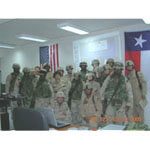 The March 16 bomb blast in the streets of Baghdad served as a stark reminder that terrorists can strike anytime, anywhere. A dozen or more U.S. soldiers had convoyed from other locales for a National Disaster Life Support (NDLS) class when the explosion occurred a few hundred yards away. They would wait about two hours while the NDLS trainer, Capt. Terry E. Raines, R.N., and the U.S. Army 745th Forward Surgical Team triaged, treated and med-evacuated 17 casualties. Five people were dead.
The March 16 bomb blast in the streets of Baghdad served as a stark reminder that terrorists can strike anytime, anywhere. A dozen or more U.S. soldiers had convoyed from other locales for a National Disaster Life Support (NDLS) class when the explosion occurred a few hundred yards away. They would wait about two hours while the NDLS trainer, Capt. Terry E. Raines, R.N., and the U.S. Army 745th Forward Surgical Team triaged, treated and med-evacuated 17 casualties. Five people were dead.
“With boots freshly stained with victims’ blood, the class began with a focus on the reality that disaster can strike at any moment,” Capt. Raines wrote to colleagues at the Health Science Center’s Center for Public Health Preparedness and Biomedical Research, which is aiding NDLS classes in Baghdad by providing instructional materials and continuing education accreditation. The American Medical Association also donated books for the Iraq courses.
The Center for Public Health Preparedness and Biomedical Research has two years of funding from the U.S. Health Resources and Services Administration to offer NDLS training in a wide area of Texas, from San Antonio south to Brownsville, west to El Paso and north to the Panhandle. Classes are scheduled in April in Canyon, May in Del Rio and June in El Paso. Three levels of courses are open to anyone interested, not just health personnel.
“The HRSA grant enables the Health Science Center to offer the classes to the public at a reduced cost,” said Harold L. Timboe, M.D., assistant vice president for research administration and initiatives at the Health Science Center. Dr. Timboe is the principal investigator for the grant and in 2001 was the founding director of the Center for Public Health Preparedness and Biomedical Research. Charles R. Bauer, M.D., professor of surgery at the Health Science Center, is the current director.
The course levels are Core, Basic and Advanced Disaster Life Support. The Core level is four hours long and introduces common terminology to “get people on the same page,” Dr. Bauer said. The Core and Basic courses can be taken as stand-alone courses; the Basic course must be taken before the Advanced course, however.
The Basic course is eight hours long and focuses on types of disasters, risk factors, triaging of casualties and clinical issues. It covers biological, chemical, traumatic explosive, nuclear/radiological and natural disaster events. Topics include avoiding contamination, areas where patients can be treated, moving onlookers where they need to be, locating supplies and notifying the right agencies.
The Advanced course is 16 hours in length and includes hands-on triage and decontamination training.
“Ensuring that a significant portion of the public has basic knowledge regarding what to expect in disasters and public health emergencies is key to the community responding in an organized manner to whatever situation occurs,” Dr. Timboe said. “Knowledge leads to cool heads. During disasters, the people who have knowledge of basic steps are going to be busy, but they will have the confidence to help contribute to bringing order out of whatever chaos there is. The more people who have knowledge, the earlier things will happen that need to happen.”
The Center for Public Health Preparedness and Biomedical Research thus far has offered the Core and Basic courses; it expects to roll out the Advanced course this summer.
The Basic Disaster Life Support course will be offered May 17 at the CHRISTUS Santa Rosa Health Care facilities in downtown San Antonio. The full calendar of courses for 2005 and more information on NDLS courses is at cphpbr.uthscsa.edu.
Capt. Raines expressed his gratitude to the Health Science Center and the AMA for supporting the courses in Baghdad. “There is no greater need for disaster management training than here in Iraq, the current front lines of the War on Terrorism,” he wrote.

